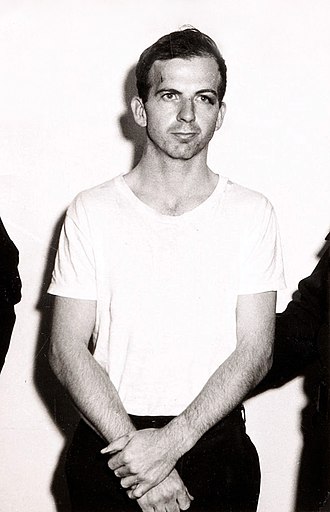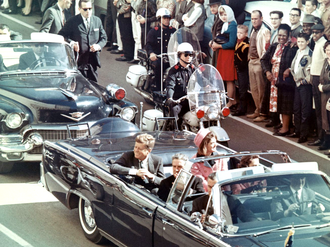
As number 2 on our Top 10 Famous Criminal Assassins list, Lee Harvey Oswald assassinated President John F. Kennedy in 1963. Here are more details about this murderer.
Biography of Lee Harvey Oswald
Introduction

Lee Harvey Oswald was born on October 18, 1939, in New Orleans, Louisiana. He was the youngest of three children and his father died two months before he was born. His mother struggled to raise her children alone, and as a result, Oswald had a difficult childhood. He moved frequently and attended several different schools before dropping out at the age of 16.
Oswald’s troubled home life may have contributed to his eventual radicalization. As a young man, he joined the Civil Air Patrol and was later drafted into the U.S. Marine Corps. After a few years of service, Oswald began to express pro-Soviet and anti-American sentiments, which led to his discharge in 1959. Oswald then moved to the Soviet Union, where he tried unsuccessfully to renounce his U.S. citizenship and become a Soviet citizen. After a few years in the Soviet Union, Oswald returned to the United States with his Russian wife, Marina.
Oswald’s early life was marked by instability and restlessness, and his experiences in the military and in the Soviet Union likely had a profound impact on his worldview. These experiences, coupled with his disillusionment with American society, would eventually lead him to commit one of the most notorious acts in American history.
In summary, Lee Harvey Oswald had a difficult childhood marked by frequent moves and a lack of stability. His experiences in the military and in the Soviet Union likely contributed to his eventual radicalization and his disillusionment with American society. These factors would ultimately lead him down a path that would make him one of the most infamous figures in American history.
Major Accomplishments and Infamy
Lee Harvey Oswald’s life was marked by a series of radical and often puzzling events, the most notorious of which occurred on November 22, 1963, in Dallas, Texas. On that day, President John F. Kennedy was assassinated, and within hours, Oswald was identified as the alleged shooter. The assassination and its aftermath put Oswald in the spotlight and cemented his place in history as one of the most infamous figures of the 20th century.
Prior to the assassination, Oswald’s life was marked by a series of tumultuous events, including a troubled childhood, a stint in the U.S. Marine Corps, and an ill-fated attempt to defect to the Soviet Union. In 1963, Oswald moved to Dallas, where he worked at the Texas School Book Depository, the building from which Kennedy was allegedly shot.
Despite a lack of concrete evidence, Oswald was charged with Kennedy’s murder and was subsequently killed while in police custody, adding another layer of mystery to an already murky case. Oswald’s involvement in the assassination has been the subject of intense debate, with numerous conspiracy theories suggesting that he may have been part of a larger plot to kill the president.
One of the most puzzling aspects of Oswald’s life is his apparent lack of motive for killing Kennedy. Despite his professed Marxist beliefs and his troubled personal history, it is not clear what, if anything, drove Oswald to take such a drastic step. His actions have been described as those of a delusional and attention-seeking individual, but the full truth of his motivations remains elusive.
The assassination and its aftermath also had a profound impact on the course of American history. The killing of a sitting president shocked the nation and sparked a wave of conspiracy theories that persists to this day. The event also led to a heightened sense of paranoia and suspicion in American politics and culture, which would only intensify in the years to come.
Despite his infamy, Oswald remains a complex and enigmatic figure, whose life and actions continue to fascinate and confound researchers and historians. The full truth of his involvement in the assassination may never be known, but his legacy is certain to endure for generations to come.
The Later Years and Assassination
After being dishonorably discharged from the Marines in 1959, Oswald drifted from job to job, finding it difficult to maintain employment due to his unstable nature and outspoken communist beliefs. In 1961, he moved to the Soviet Union, where he tried unsuccessfully to defect and eventually returned to the United States in 1962 with his wife and young daughter.
Upon his return, Oswald’s political leanings and erratic behavior continued to cause concern among those around him. He eventually moved to Dallas, Texas, where he became involved with the Fair Play for Cuba Committee, a pro-Castro organization. He also began to frequent the local offices of the Communist Party USA, although he was not officially a member. He continued to express support for Communist ideals and even attempted to infiltrate anti-Castro organizations in New Orleans. In April 1963, Oswald purchased a rifle and began practicing his marksmanship skills.

On November 22, 1963, President John F. Kennedy visited Dallas, Texas, and was riding in an open convertible during a parade when he was shot and killed by Oswald. Oswald had obtained a job at the Texas School Book Depository building along the parade route and used a rifle to fire three shots at Kennedy’s motorcade, hitting the president twice and killing him.
Oswald fired three shots from the sixth floor of the Texas School Book Depository building, killing the President and wounding Texas Governor John Connally.
Oswald was arrested for the assassination and maintained his innocence, claiming to be a patsy and denying any involvement in the killing. He was later killed while being transferred from police custody to a county jail by nightclub owner Jack Ruby, who shot Oswald in front of reporters and television cameras.
Legacy and Unanswered Questions regarding Lee Harvey Oswald
After the assassination, Oswald fled the scene and was later arrested in a movie theater in the Oak Cliff neighborhood of Dallas. He was charged with the murder of Officer J.D. Tippit, who had been shot and killed by Oswald shortly after the assassination. Oswald denied killing anyone and maintained his innocence until his death.
On November 24, 1963, Oswald was being transferred from police headquarters to the county jail when he was shot and killed by nightclub owner Jack Ruby. Ruby had a history of mental illness and claimed that he killed Oswald to spare Jackie Kennedy the trauma of a trial.
Oswald’s assassination of President Kennedy and his subsequent killing by Ruby have been the subject of numerous conspiracy theories, with some suggesting that Oswald was part of a larger plot to kill the President. However, the official investigations, including the Warren Commission and the House Select Committee on Assassinations, concluded that Oswald acted alone.
The assassination of President Kennedy by Lee Harvey Oswald remains one of the most controversial and hotly debated events in American history. Despite numerous investigations and inquiries, many questions surrounding the assassination and Oswald’s motives remain unanswered to this day. The tragic event not only shocked the nation, but also marked a turning point in American history, leading to increased security measures for public figures and forever altering the political landscape of the United States.
Despite his infamy, Oswald remains a complex and mysterious figure. Some view him as a politically motivated assassin, while others see him as a disturbed individual who acted on his own. The assassination of President Kennedy and its aftermath have had a lasting impact on American culture and politics, and continue to be the subject of intense scrutiny and debate.
Return to Top 10 Criminal Assassins or go to the Top 10 countdown list directly to explore another Famous Person Top 10 list.
